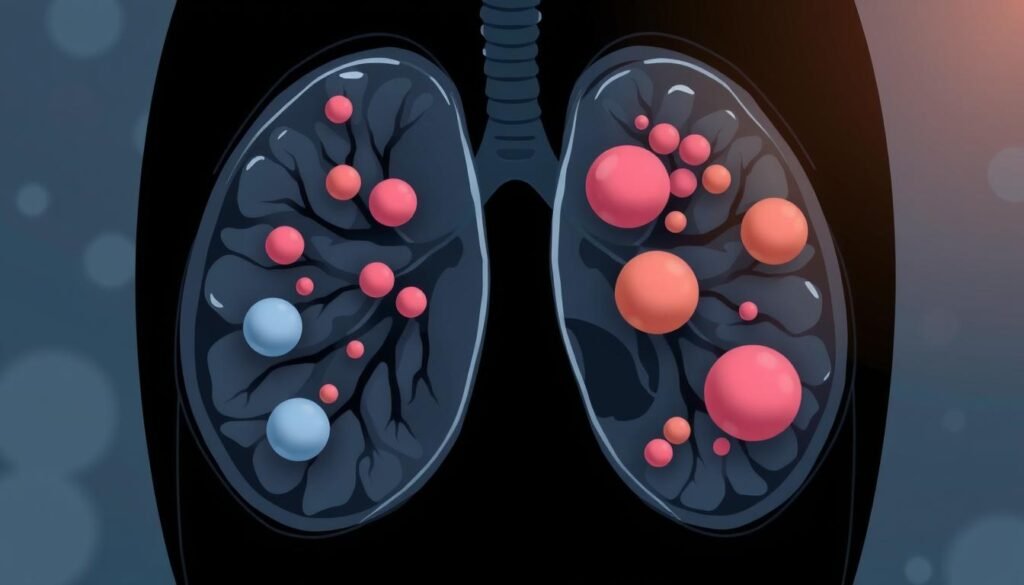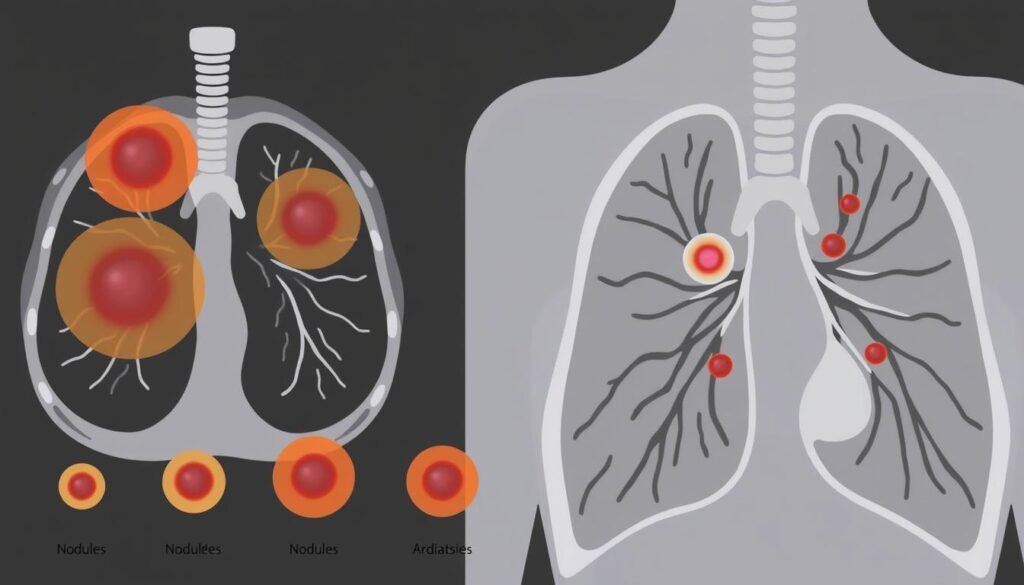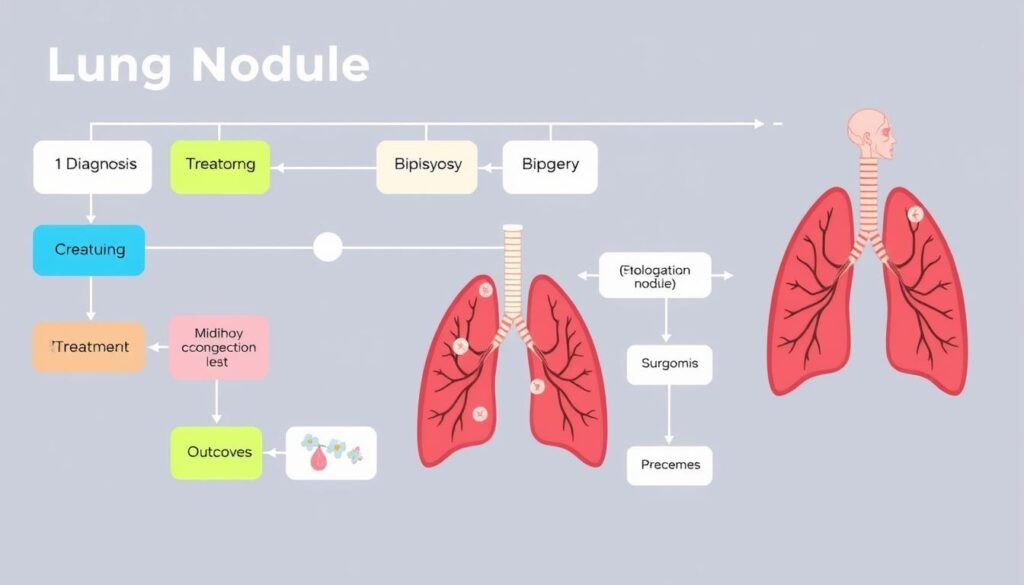By the age of 50, nearly half of all people have at least one lung nodule. It’s crucial to understand lung nodules. This is because some may be signs of serious conditions like lung cancer. In the Chicagoland area, almost 85% of those screened for lung cancer find nodules. This article will help explain what pulmonary nodules are. It covers their causes, symptoms, and how they are managed. This information is especially important for lung cancer screening.
Key Takeaways
- Lung nodules are prevalent, with many individuals having them by age 50.
- Most lung nodules are benign and do not indicate cancer.
- Regular monitoring and follow-up strategies vary based on nodule size.
- Imaging techniques are essential for accurate lung nodule diagnosis.
- Understanding the characteristics of nodules can aid in differentiating between benign and malignant types.
- Collaboration with healthcare providers is vital for managing lung nodules effectively.
Introduction to Lung Nodules
Lung nodules are a common result during scans like X-rays and CT scans. Studies show that up to half of adults checked might have them. Learning about them can ease worry, as they are mostly not cancer and come from harmless causes.
These pulmonary nodules are usually smaller than 10 millimeters (about ½ inch). While a small number may be cancer, certain risk factors like age, bigger nodules, or a smoking history can increase fears. Even small nodules need to be checked more, often with CT scans over a couple of years.
It’s normal to feel anxious about possible lung nodules. But, they mostly grow slow, changing little over many months. Small nodules might not need a biopsy right away due to risks. Doctors suggest watching them closely based on their size and shape. Routine checks and tools like Nodify Lung tests help judge the risks of lung nodules.
As doctors get better at diagnosing lung nodules, it helps to have support and resources. For more information on lung cancer categories, visit this link.
What Are Lung Nodules?
Lung nodules are small tissue masses inside the lungs. They’re often found during imaging tests. These nodules show up as round, white spots on chest X-rays or CT scans. They are usually less than 3 cm in size. Most of them are not cancerous.
Definition and Appearance
These growths, known as pulmonary nodules, come from different causes. They usually don’t cause symptoms. The way lung nodules look in imaging helps doctors figure out what they are. Doctors might need more scans to watch the nodules over time.
Prevalence in Imaging
About half of all chest CT scans show lung nodules in adults. Even though they’re common, less than 5% turn out to be cancer. Most nodules are found by accident when checking for other health issues. This tells us how important CT scans are for finding lung nodules.
Common Causes of Lung Nodules
Lung nodules have many causes. It’s key to understand these to manage and treat lung nodules well. Some causes are harmless, but others might be serious.
Infections and Inflammation
Infections can cause lung nodules to appear. Bacterial infections like tuberculosis and pneumonia are common. Fungal infections also play a role. Autoimmune diseases can cause inflammation, which leads to nodules. This understanding is critical for good treatment and management.
Non-cancerous Tumors
Some non-cancerous tumors show up as lung nodules. These include hamartomas and other benign growths. They don’t usually need aggressive treatment. These tumors grow slowly and are often checked over time with regular imaging.
Underlying Conditions
Conditions like sarcoidosis and rheumatoid arthritis also lead to lung nodules. Knowing these underlying conditions helps assess lung nodule risk. A detailed medical history is vital. It helps with treatment plans and managing lung nodules proactively.
Understanding Lung Nodules
Lung nodules are found quite often, especially during CT scans of the lungs. As many as 35% of these scans show nodules. Sometimes, a person might have more than one nodule.
Most lung nodules don’t change size. However, a few could point to early signs of lung cancer. The risk of a nodule being cancer is usually low. Most are not harmful.
Nodules can form for different reasons. These include past infections or scars. Other non-cancer causes also exist. Understanding these reasons helps doctors treat lung nodules better.
Finding lung nodules early is key to treating them right. Regular scans help doctors keep an eye on them. They might use PET scans or even biopsies.
This careful monitoring is part of a custom care plan. It aims to give patients attention and support. A nurse navigator often helps patients through this process.
| Characteristic | Details |
|---|---|
| Incidence | Up to 35% of CT scans reveal lung nodules. |
| Multiplicity | It is possible to find more than one nodule at a time. |
| Cancer Risk | Small chance of nodules indicating early lung cancer. |
| Commonality | Many nodules are incidental discoveries during tests for other issues. |
| Surveillance Methods | Includes imaging, biopsies, blood tests, and more. |
Symptoms Associated with Lung Nodules
Many people with pulmonary nodules don’t show symptoms. If nodules are big or near airways, symptoms might appear. Knowing these signs helps in understanding lung nodules better.
It’s key to keep an eye on respiratory health changes. This is especially true for those with lung nodules or at risk for lung cancer.
When Symptoms Occur
Symptoms usually show up when nodules get larger or impact nearby tissue. It’s crucial to know that serious symptoms need more checks. Tools like lung cancer screening help catch changes early, lowering lung cancer risks.
Common Symptoms to Monitor
Look out for these signs if you have lung nodules:
- Chronic cough
- Blood-tinged mucus
- Shortness of breath
- Wheezing
- Fever or unexplained respiratory infections
It’s important to track these symptoms. Doing so helps treat lung nodules on time. This way, you can take steps that fit your health risk.
| Symptom | Significance |
|---|---|
| Chronic cough | Persistent cough can indicate irritation or blockage. |
| Blood-tinged mucus | May signal more serious underlying issues. |
| Shortness of breath | Could be a sign of obstruction or lung involvement. |
| Wheezing | Indicates airway constriction or blockage. |
| Fever | Often points to infection or inflammation. |
Diagnosis of Lung Nodules
It’s very important to correctly diagnose lung nodules to manage them well. Doctors use several imaging methods to find and look at these tiny spots. Chest X-rays are used first, but CT scans show more detail. They help measure how big the nodule is and what it looks like.
Imaging Techniques
Many imaging techniques are essential in spotting lung nodules. Chest X-rays catch a small percentage, but CT scans find about 13% of them. Learning about these methods is crucial. They let doctors see if the nodules are solid or not. Non-solid ones are split into two kinds, making it easier to figure out the next steps.
Importance of CT Scans
CT scans give a clear picture of lung nodules. They show how the nodules are growing. This helps tell if they are benign or could be cancer. For nodules over 30 mm, the chance of cancer is higher. So, CT scans are very important. They help doctors understand the risk and decide on the best care based on what they see and the patient’s history.

Lung Nodule Management Strategies
Lung nodule management calls for a thorough review for each case. Matters like the nodule’s size, and the patient’s risk factors are essential. Proper lung nodule management aims to find the right balance. This balance is between watching the nodule and acting fast if needed.
Monitoring versus Immediate Action
Healthcare teams often have to choose between watching or acting fast on pulmonary nodules. If a nodule is found during lung cancer screening, checking it again later is crucial. The nodule’s size and look help decide the best action. Smaller solid nodules, less than 6 mm, usually suggest a low chance of cancer, making watching them closely a good option.
Follow-up times differ based on the nodule’s size:
- Solid nodules
- Solid nodules 6-8 mm: Check again in 3-6 months
- Solid nodules >8 mm: Seeing a specialist soon may be needed
Personalized Follow-up Plans
Making a follow-up plan just for you is key in handling lung nodule diagnosis and care. Such plans should look at each patient’s own health history and past imaging. Nodules showing certain risky signs or growing need closer watching.
For cases like ground glass nodules, checking more often may be needed. The main aim is giving care that fits the patient’s specific health needs perfectly.
| Nodule Size | Follow-up Recommendation | Risk of Malignancy |
|---|---|---|
| <6 mm | No follow-up required | Low (under 5%) |
| 6-8 mm | Check again in 3-6 months | Moderate |
| >8 mm | See a specialist soon | Higher risk |
Lung Nodule Risk Assessment
Understanding lung nodules is key in lung cancer detection. Assessing various factors helps decide the next steps. This evaluation is crucial for managing lung nodules and telling patients about their risks and what follow-ups they need.
Factors to Consider
Some factors are important in assessing lung nodules:
- Age: The risk of lung cancer goes up with age.
- Smoking History: Smoking is a top cause, linked to 90% of lung cancer deaths.
- Family History: Having family members with lung cancer can increase your risk.
- Nodule Characteristics: Nodule size, shape, and makeup from scans are key to risk evaluation.
How fast a lung nodule grows tells us a lot. Quick growth could mean cancer. PET scans show which nodules are more active and need extra checks.
Role of Medical History
Medical history is vital in assessing lung nodule risks. Past illnesses, carcinogen exposure, and family cancer history guide our strategy. Nonsmokers who’ve breathed in secondhand smoke also have a higher risk of lung nodules or cancer.
If you want to know more about lung cancer types, like squamous cell, this guide is helpful.

Differentiating Between Benign and Malignant Nodules
In lung nodule diagnosis, it’s key to tell benign from malignant ones. Various imaging tests give vital info for this.
Appearance on Imaging Tests
Imaging studies help assess lung nodules well. Benign nodules often have smooth edges and clear borders. Meanwhile, malignant ones may have rough edges and calcifications. PET-CT scans are especially good, spotting cancers 95% of the time. A study shows if a nodule’s contrast is under 15 Hounsfield units, there’s a 99% chance it’s benign.
Growth Patterns and Follow-ups
Watching how lung nodules change is crucial. Nodules over 3 cm are seen as lung masses, and often thought to be cancerous at first. Studies show nodules that look partly cloudy have a 63% chance of being cancer. A 3D ratio over 1.78 or a polygonal shape suggests a nodule is benign, as Japanese research says. It’s vital to keep checking nodules, especially if they look unusual.
For latest info on using tech to classify lung nodules, see this article.
Lung Nodule Treatment Options
The way doctors handle lung nodules can depend on their size, how long they’ve been there, and cancer risk. Doctors often watch small, stable lung nodules closely instead of rushing into treatment. They use imaging tests to make sure the nodules don’t change, which helps avoid stress for patients.
Observational Management
Most often, with nodules less than 6 mm across, the risk of cancer is very low. Such nodules have less than a 1 percent chance of being cancer. Regular checks with scans can spot any changes over time. If there’s no growth or bad signs, there might be no need for active treatment. This means patients can be monitored without harsh procedures.
Surgical Interventions
For bigger, or suspicious nodules, surgery might be needed. Options range from less invasive surgery to more complex operations. The choice often depends on the nodule’s details and the patient’s health and history. Talking with lung cancer specialists is key to figure out the best lung nodule treatment plan.

| Nodule Size Range (mm) | Risk of Cancer (%) |
|---|---|
| 2 mm or smaller | Very small risk |
| 2 to 6 mm | 1% or lower |
| 6 to 8 mm | 2% or lower |
| 8 to 10 mm | 9-10% |
| Larger than 10 mm | Approximately 15% |
Dealing with lung nodules means using careful diagnosis and treatment plans made just for you. With new discoveries in how to treat lung nodules, research and updated methods are helping to tackle the various challenges they present.
Importance of Lung Cancer Screening
Lung cancer screening is key for early detection and handling of lung nodules. It helps high-risk individuals learn more through regular check-ups. Early finding means better treatment choices, leading to improved survival rates. Knowing about screening guidelines helps more people watch their lung health closely.
Who Should Get Screened?
Screening is advised mainly for certain groups:
- Individuals aged 50 to 80 years.
- Those with at least 20 pack-years of smoking, including current smokers.
- People who stopped smoking in the past 15 years.
Despite advice to screen yearly, under 6% actually do. Educating about early detection’s benefits could increase lung cancer screening. This could save many lives.
Screening Methods
The low-dose CT scan is the main lung cancer screening method. It’s good for finding early lung cancer signs while keeping an eye on nodules. Its advantages include:
- Less radiation—80% lower than standard CT scans.
- Quick results, often within a day.
- A 20% drop in lung cancer deaths found in the National Lung Screening Trial.
Using cutting-edge technology helps catch lung cancer early on. This can greatly improve outcomes for people with lung nodules.
| Screening Age | Smoking History | Frequency of Screening |
|---|---|---|
| 50-80 years | 20 pack-years or currently smoking | Yearly |
| 50-80 years | Quit smoking within the last 15 years | Yearly |
Conclusion
It’s essential to understand lung nodules well. This helps in managing them and lowers patient anxiety. Each year, about 150,000 new cases are found in the U.S. alone. Knowing the causes, signs, and tests for lung nodules is key.
Patients need to stay alert and get regular check-ups. As people get older, lung nodule risks go up. This raises the need for custom lung cancer screening methods. Despite lung cancer being a top cause of death from cancer, new screening methods have led to better survival rates over 20 years.
Talking openly about how to handle lung nodules is important for patients and doctors. This helps improve patient care and decision-making. Knowing more about lung nodules helps patients take better care of their lung health.
Keeping an eye on lung nodules is crucial. Through regular check-ups and risk analysis, people can deal with lung nodules positively. This approach brings clarity and boosts confidence in the face of lung health challenges.